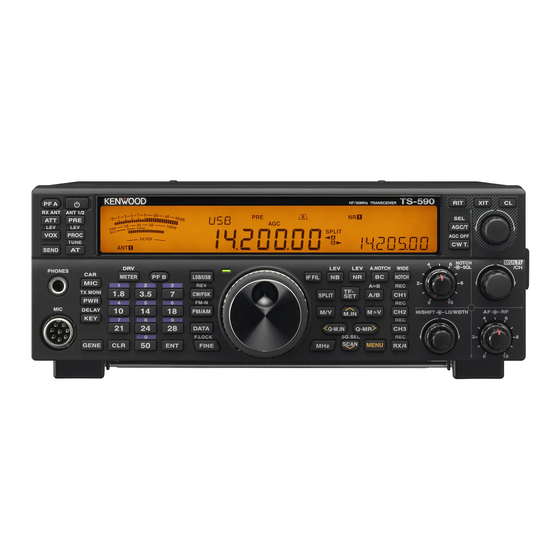
Kenwood TS-590SG Setting Manual
Usb audio
Hide thumbs
Also See for TS-590SG:
- Service manual (155 pages) ,
- Instruction manual (96 pages) ,
- Manual (76 pages)
Table of Contents
Advertisement
Quick Links
Advertisement
Table of Contents

Summary of Contents for Kenwood TS-590SG
- Page 1 TS-590SG USB Audio Setting Manual © B5A-0320-00 (October/31/2014)
-
Page 2: Table Of Contents
However, there is a possibility of misprints and of descriptions that may cause misunderstanding. JVC KENWOOD Corporation bears absolutely no responsibility for damages arising thereof. JVC KENWOOD Corporation may revise and amend the products information described in this document without notice. JVC KENWOOD Corporation bears absolutely no responsibility for damages arising thereof. -
Page 3: About The Ts-590Sg Usb Audio Function
This setup guide explains how to set up the TS-590SG to use its USB audio function and how to use the ARUA-10 software to control input/output routes of the USB audio signals from a computer. -
Page 4: Operation Using The Usb Audio Function
Diagram 1: Operation Using the USB Audio Function The left side of the diagram shows the TS-590SG unit while the area in the square on the right- side indicates the computer. The TS-590SG and the computer are connected by a USB cable. -
Page 5: Installing The Arua-10 Software
Download and install the driver from the following KENWOOD website: http://www.kenwood.com/i/products/info/amateur/software_download.html 3.3 About Virtual COM Port Driver When connecting the TS-590SG to a computer with a USB cable for the first time, the “New Hardware Detected Wizard” message appears. This is the install prompt for the Virtual COM Port. - Page 6 If you are not using an ARCP-590G or Computer Control Command, there is no need to install the Virtual COM Port. However, if it is not installed, the Wizard message appears every time the USB cable is connected, so we recommend installation. When the “New Hardware Detected Wizard”...
-
Page 7: Settings
The default value for all settings is 4. 4.1.3 Mixed Beep Setting to External Audio Outputs With the TS-590SG default mode, only received audio signals that do not include beeps or side tones are output as audio signals from the ACC2 connector and the USB connector as USB audio signals. -
Page 8: Data Vox Settings
When using this function for the first time, we recommend connecting a dummy load to the TS-590SG to perform checks and adjustments. 4.1.5 Data VOX Delay Time Setting Set the VOX Delay Time Setting when using the Data VOX function. -
Page 9: Setting To Transmit An Usb Audio Input
4.2. Setting to Transmit an USB Audio Input The [SEND] keys on the PTT of the microphone connected to the TS-590SG, and on the TS-590SG control panel, are the method for transmitting audio input to the microphone connected to the TS-590SG, so even if these operations are implemented, audio entered as audio signals from USB cannot be transmitted. -
Page 10: Arua-10 Settings
Follow the steps below to set up the ARUA-10 1) Connect the TS-590SG and computer using a USB cable. 2) To launch the software, select Start Button > Programs > Kenwood > ARUA-10. 3) After launching the ARUA-10, a “Task Tray” icon appears. - Page 11 Next, follow the steps below, to confirm that the intended audio transmission route is configured. 8) Connect the dummy load to the TS-590SG. 9) If the TS-590SG is in Split mode, switch to Simplex mode, with the mode set to SSB (USB or LSB). 10) Enable the transmission monitor function.
- Page 12 12) From the ARUA-10 window shown above, click the “TX AF Test” button. If test signals are played from the internal TS-590SG speakers, the system is set up correctly. Push the PF key set to the DATA SEND function to return to audio reception mode.
-
Page 13: Limitations Important
5. Limitations IMPORTANT! 5.1 USB Port Connectivity Limitations If the PC and TS-590SG are connected via a USB cable, audio transmissions can be transmitted using the USB audio function. In principle, however, there is a delay with USB audio signals, plus sound may be delayed or lost depending on the PC performance and load status. -
Page 14: Frequently Asked Questions
Installation Where can I get the USB audio You do not need to download the drivers. drivers? When the computer and TS-590SG are connected via USB for the first time, the standard driver for your operating system is automatically installed. - Page 15 I cannot hear audio from the It is possible that the USB audio output transceiver over the computer level from the TS-590SG is too low. Try speakers. adjusting Menu No. 72. If there is a mistake in the ARUA-10 settings, audio reception sent by USB audio to the computer is not played from the computer speakers.
- Page 16 The transceiver does not In order to transmit VOX when voice data transmit VOX when audio input input is received through the rear is from the computer terminal, specific menu settings are microphone. required. Refer to “4.1.4 Data VOX Settings” and “4.1.6 Data VOX Gain Setting”...
- Page 17 Question Answer Operation The transceiver transmits, even When the DATA VOX function is ON, for with no voice input from the laptop computers with internal microphone, when the DATA microphones, sounds near the computer VOX function is set to ON. that are loud enough to trigger the VOX are sent to the transceiver and Turning the DATA VOX to ON...
- Page 18 If you want can no longer be heard. to stop audio reception, stop the ARUA-10 operation. Also, when not using the TS-590SG, we recommend you disconnect the USB cable from the computer.









